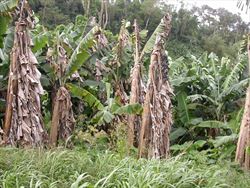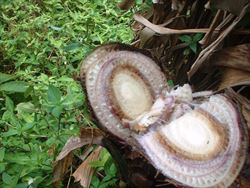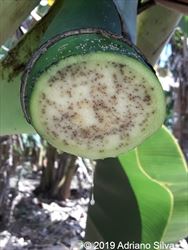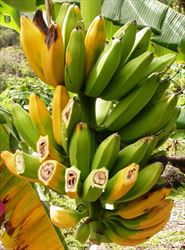- Widespread. Hawaii on Heliconia.Not recorded in Pacific island coountries.
- Major bacterial disease of Cavendish (AAA varieties) in commercial plantation; same bacterium that causes bugtok of plantains (ABB/BBB varieties). Different strains of moko exist, some soilborne, other insect transmitted.
- Sources of infection:
- If from soil: yellowing and wilting of leaves.
- If from insects: male flowers and flower stalks blacken and shrivel. Fruits infected with internal brown or grey rots; vascular tissues (producing creamy ooze) move throughout the plant causing leaf collapse and death.
- Spread: insects; water; suckers; on knives. Survival in soil up to 18 months, but possibly survival on weeds.
- Biosecurity: risk from unofficial introduction of diseased suckers for propagation, and trade in fruit. Official movement of germplasm should always follow the FAO/IPBGR Technical Guidelines.
- Biocontrol: none.
- Cultural control: most important recommendations for smallholders: (i) monitoring and cutting down and burying (in place) diseased plants as soon as seen; (ii) removal of unopened male flower buds (called 'de-budding') using forked stick; and (iii) decontaminating knives (bleach). Others: disease-free suckers for planting; do not plant near diseased plots (especially downwind); weed; bag flowers after emergence until fruit set (if bell removed); isolate diseased mats with trench; fallow or use legume cover crops. Selection from within diploid AA varieties have shown resistance.
- Chemical control: not a method to use.
Pacific Pests, Pathogens and Weeds - Online edition
Pacific Pests, Pathogens, Weeds & Pesticides
Banana moko disease (525)
Moko disease. Note, moko is caused by the same bacterium (Ralstonia solanacearum) that causes bugtok in the Philippines). Moko is the name used to describe the yellowing of leaves and wilt on Cavendish (AAA*) bananas grown on plantations, whereras bugtok is the name used to describe rots of flowers and fruits on cooking bananas (ABB/BBB) grown in the Philippines by smallholders for local markets (see Fact Sheet no. 524). This fact sheet describes the disease on Cavendish AAA varieties ground by smallholders.
Ralstonia solanacearum race 2, biovar 1; previously, it was known as Pseudomonas solanacearum, Burkholderia solanacearum. Recently, molecular analysis moko disease (and that causing bugtok in the Philippines), puts race 2 in Phylotype 11 on origin (American) and evolution. There are several strains. Bugtok and moko are considered to be one and the same disease, but expressing different symptoms in different banana varieties (see Fact Sheet no. 524).
AUTHOR Grahame Jackson
Information from Blomme G, et al. (2017) Bacterial diseases of banana and enset: Current state of knowledge and integrated approaches toward sustainable management. Frontiers in Plant Science. (https://www.frontiersin.org/articles/10.3389/fpls.2017.01290/full#B66); and (including Photo 1)Liberato JR & Gasparotto L (2006) Moko disease of banana (Ralstonia solanacearum). PaDIL - http://www.padil.gov.au; and CABI (2021) Ralstonia solanacearum race 2 (moko disease). Crop Protection Compendium (https://www.cabi.org/cpc/datasheet/44999); and Moko (Undated) Fact sheet. Plant Health Australia. Queensland Government and Australian Banana Growers' Council Inc. (https://www.planthealthaustralia.com.au/wp-content/uploads/2013/01/Moko-FS.pdf); and Kemelyn Douglas (Undated) Control of moko diseased, Ralstonia solanacearum, race 2, biovar 1. CABI Plantwise Knowledge Bank. (https://www.plantwise.org/KnowledgeBank/factsheetforfarmers/20137804483); and Biosecurity Australia (2008) Final Import Risk Analysis Report for the Importation of Cavendish Bananas from the Philippines, Part C. Biosecurity Australia, Canberra. (https://www.awe.gov.au/sites/default/files/sitecollectiondocuments/ba/plant/bananas-philippines/PART_C_-_FINAL_-_COLOUR_COVER_AND_B-W_REST_-_John_081106.pdf); and from Álvarez E, et al. Current status of Moko disease and black sigatoka in Latin America and the Caribbean, and options for managing them. Cali, CO: Centro Internacional de Agricultura Tropical (CIAT); Food and Agriculture Organization of the United Nations (FAO), 40 p. (CIAT publication No. 404). (https://www.fao.org/3/i3400e/i3400e.pdf). Photos 1,2,5&7 Emmanuel Wicker, Plant Health Institute of Montpellier, CIRAD, Montpellier, France. Photos 3,4,6&8
Adriano Freire Silva, Instituto Agronomico de Pernambuco (Agronomical Institute of Pernambuco), Estação Experimental de Belém de São Francisco, Brazil.
Produced with support from the Australian Centre for International Agricultural Research under project HORT/2016/185: Responding to emerging pest and disease threats to horticulture in the Pacific islands, implemented by the University of Queensland, in association with the Pacific Community.
*The codes ABB and BBB are the amount of Musa acuninata and Musa bulbisiana (parents of many banana varieties grown) represented in each banana variety. An internationally recognised scoring system is used to determine the proportion.











